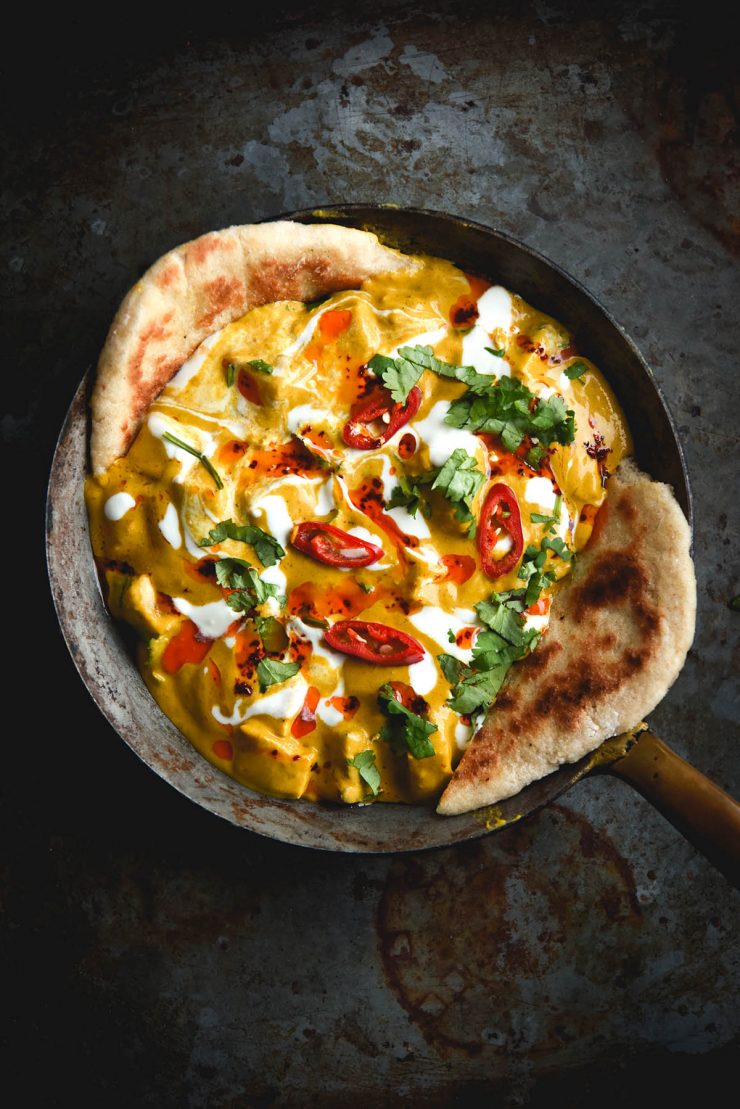
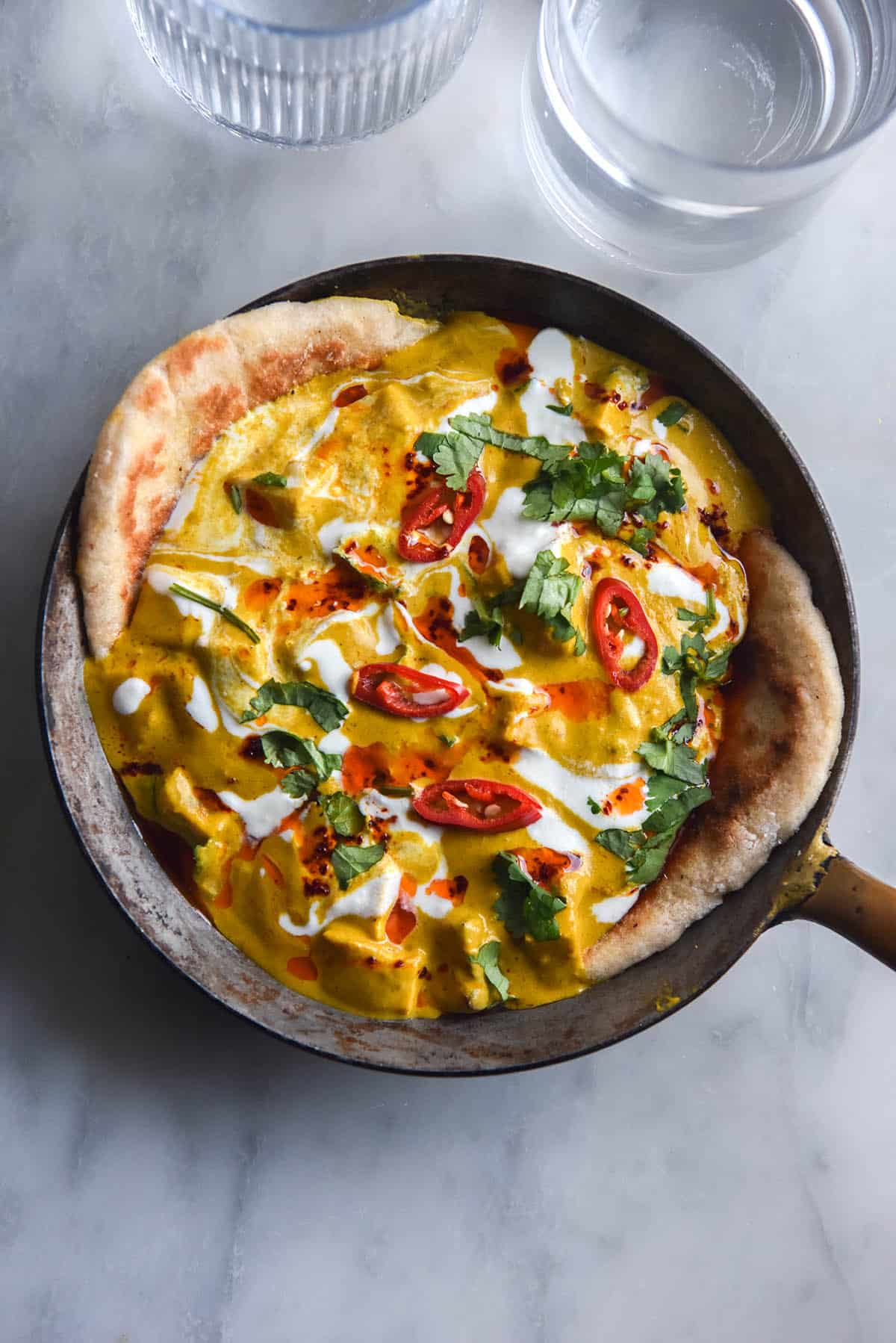
This FODMAP friendly shahi paneer was a crowning glory of my first cookbook. A dish that I used to order all the time, I was really proud to have nailed down my own version. Long story short, the version in the book contained onion which is not the version of this recipe I hoped to take to print. So, here we are today with the FODMAP friendly shahi paneer I intended to share. With a few tweaks, too, because I have learnt even more tricks since the book was published (and because Monash recently changed the threshold for tomatoes).
FODMAP friendly shahi paneer
This shahi paneer is made without onion and garlic to make sure it is FODMAP friendly. It uses spring onion greens and asafoetida to replace the rich onion and garlic flavour. To keep the lactose content down, you can also make your own lactose free paneer. It’s a delicious and cost effective way to add paneer to your curry.
This dish is vegetarian and can be made vegan with a plant based milk/cream and tofu instead of the paneer.
How this recipe differs from traditional shahi paneer
- The onion and garlic are replaced with spring onion greens and the option to add asafoetida and pickled garlic
- Tomatoes have the option to be (half) replaced with grated carrot and pumpkin for sweetness and bulk
- I have omitted the nuts to ensure people with nut allergies and FODMAP concerns are included
- Cardamom doesn’t seem to be included in recipes online, but the shahi paneer I’ve always had had a hit of cardamom. I’m not sure if it’s an inauthentic addition or whether it’s more of a matter of choice
- There is the option to use plant based milk, yoghurt and tofu in place of the milk, cream and paneer
FODMAP notes
I should note re: the original recipe: onion (and everything else) can be eaten on a FODMAP diet if you don’t react to it. The point is never to exclude everything long term. In fact, it is to include everything that works for you long term. If that happens to be onion, eat onion! (lucky you, I’m jealous).
As annoying as it to add another component, I have swapped out some of the tomatoes for steamed pumpkin here. This is to keep the recipe in line with Monash’s update of the fructose in tomatoes. If you don’t have any issues with tomatoes, absolutely feel free to use them instead (I have included this in the recipe notes). You can also use my low FODMAP Nomato sauce to replace tinned tomatoes.
I use lactose free cream in this recipe. You can use regular cream if lactose is not an issue, or a dairy free alternative if that is what works for you. Needless to say, use a dairy free alternative to make this vegan.
Again, for lactose concerns, you can use cubed firm tofu instead of paneer. I quite like using tofu and paneer to add a bit of extra protein in.
A note on the nuts
Nuts are used in curry bases to thicken and add creaminess. Needless to say, nuts aren’t for everyone,so I decided not to use them in this FODMAP friendly shahi paneer. If you’d like to add something to thicken it up a little, I have done a bit of digging as to some nut substitutes. Some suggestions I have found are:
- Chickpeas (use canned for FODMAP purposes) for that bland creaminess and thickening
- A little tiny bit of cornstarch to thicken the gravy up
- Add a little less liquid or compensate with cream. Thick cream would be good, if you don’t have any lactose concerns
- Tomato paste
Tomatoes or pumpkin?
If you’re not new to the FODMAP diet and Monash app, you’ll know that the FODMAP friendly threshold for tomatoes was recently lowered. This means that only half a common tomato (65g) is allowed per serve, IF you have issues with fructose and/or with tomatoes. The change in FODMAP status elucidated to some people that they could in fact eat more than half a tomato, despite the change. So, if you’re a person who can eat tomatoes with no issue, use the tomato option.
If tomatoes create issues for you, there’s an option! To replace half the tomatoes, you have the option to use grated pumpkin and a good splash of lime juice. The pumpkin will help replicate the sweetness and bulk, while the lemon/lime juice will add the acidity. I find with the pumpkin option that it’s good to add a little extra spice to help disguise a vague taste of pumpkin soup.
I would suggest adding 3-5 extra cardamom pods and 1 teaspoon extra of garam masala powder. You might even add a little extra green chilli, if you enjoy a bit of spice.
More FODMAP friendly vegetarian recipes
- The tikka masala inspired FODMAP friendly curry
- Vegetarian Thai Green curry and Pad Thai
- FODMAP friendly daal (or not quite daal)
- Vegetarian chilli sin carne
- My old favourite, the vegan, FODMAP friendly bolognese
- Gluten free, gum free potato gnocchi
- Vegetarian or vegan Shepherd’s Pie
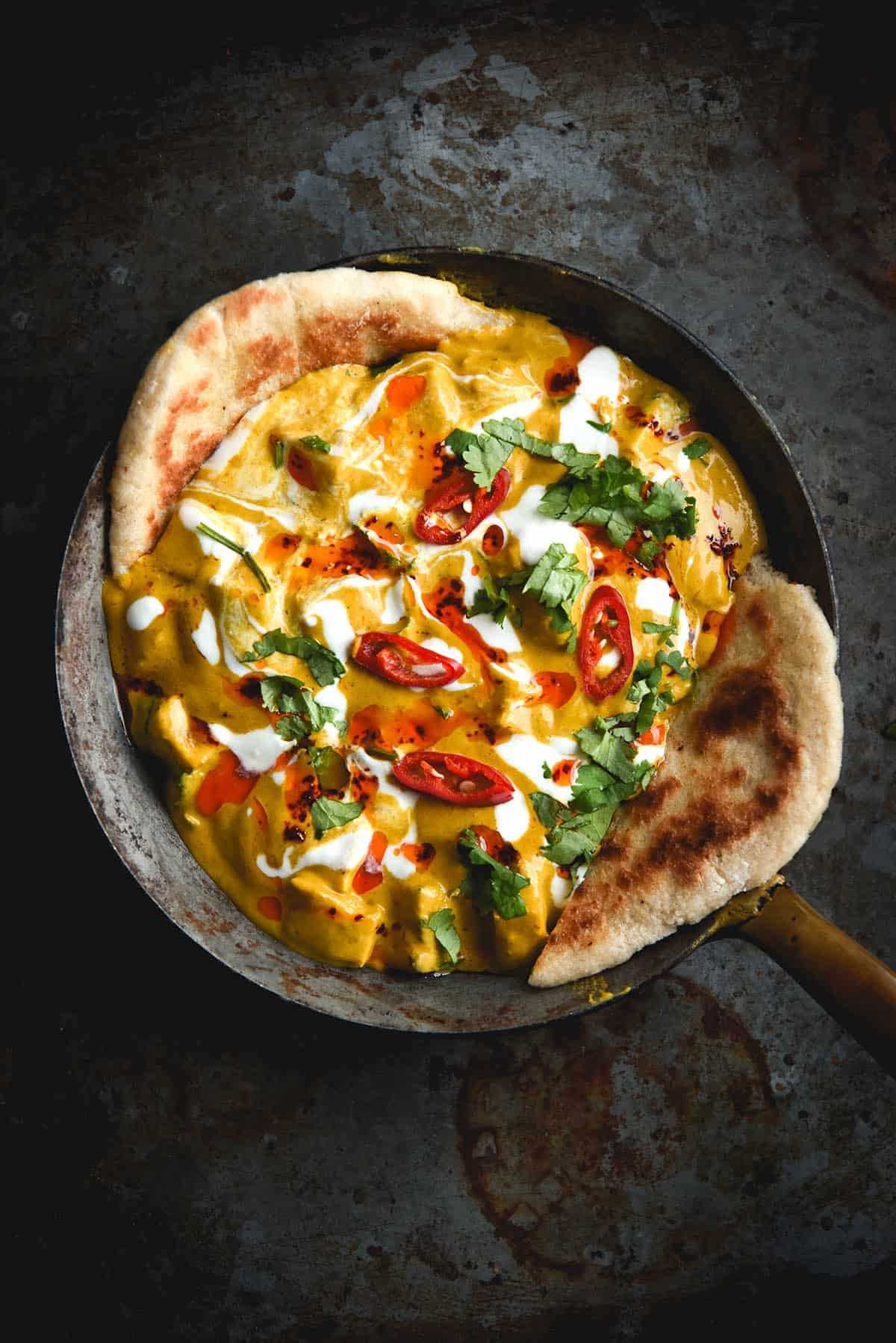
To make the accompanying gluten free flatbreads, follow this link here and enjoy!

FODMAP Friendly shahi paneer
Ingredients
For the shahi paneer:
- 200-400 g paneer cubed (see notes)
- 200-400 g firm tofu cubed (optional, see notes)
- 60ml (3 tablespoons)* neutral flavoured oil I used vegetable
- 50g (1 bunch) of spring onion greens chopped
- Greens of 1 leek thoroughly washed and finely chopped (optional, see notes)
- 1 bunch of coriander roots thoroughly washed and chopped (optional, see notes)
- 150 g 1 medium/large carrot, grated
- 4 common tomatoes OR 2 common tomatoes and 150g grated Kent pumpkin see notes
- 50 g ginger grated
- 1-2 green chillies de-seeded and chopped (see notes)
- 1 tablespoon + 1 teaspoon coriander powder
- 1/2 teaspoon turmeric powder
- 15-20 cardamom pods crushed, husks discarded, seeds reserved
- 2-3 teaspoons garam masala
- 250ml (1 cup)* milk of choice (I used full cream lactose free)
- 250ml (1 cup)* lactose free cream
- Seasoning to taste
- Juice of up to 1 lime to taste
To serve:
- Remaining 50g cream from a 300g/ml tub
- Coriander
- 1 red chilli very finely chopped (optional)
Instructions
- In a dry pan over a medium high heat, dry fry the paneer and/or tofu cubes until golden.
- In a large skillet over a medium heat, heat the oil. Once warmed, add the spring onions and optional leeks and coriander roots. Cook for 3-4 minutes or until softened and fragrant, then add the carrot and tomatoes (as well as the pumpkin if you are using it).
- Cook until completely soft, about 10-15 minutes. Once it is, transfer the mixture to a blender with a steam valve. Blend until smooth, about 3 minutes. If you are using a Nutribullet or anything with a hole for steam to escape, wait until the mixture is cool. The pressure will be too much and you will probably explode the blender and hurt yourself. Once silky smooth, set aside.
- Combine the ginger, chilli and spices in a small food processor until smooth. You can also use a mortar and pestle. You might need to add a little water to make a paste consistency.
- Add a tablespoon extra oil to the (currently empty) skillet and add the ginger spice paste. Cook for a minute or so until fragrant, then add the blended vegetables back into the skillet. Stir thoroughly to combine and cook for a few minutes.
- Add the milk and cream and stir to combine. Season to taste and adjust for anything you think is missing. Add the lime juice to taste. Finally, add the paneer and/or tofu cubes to the pan and cook for a few minutes until they are heated through. Serve with a drizzle of cream (tubs are generally 300ml in Australia, so you will have 50g left) some finely sliced red chilli and the remaining coriander. Goes very well with the gluten free flatbread linked in the body of the post.


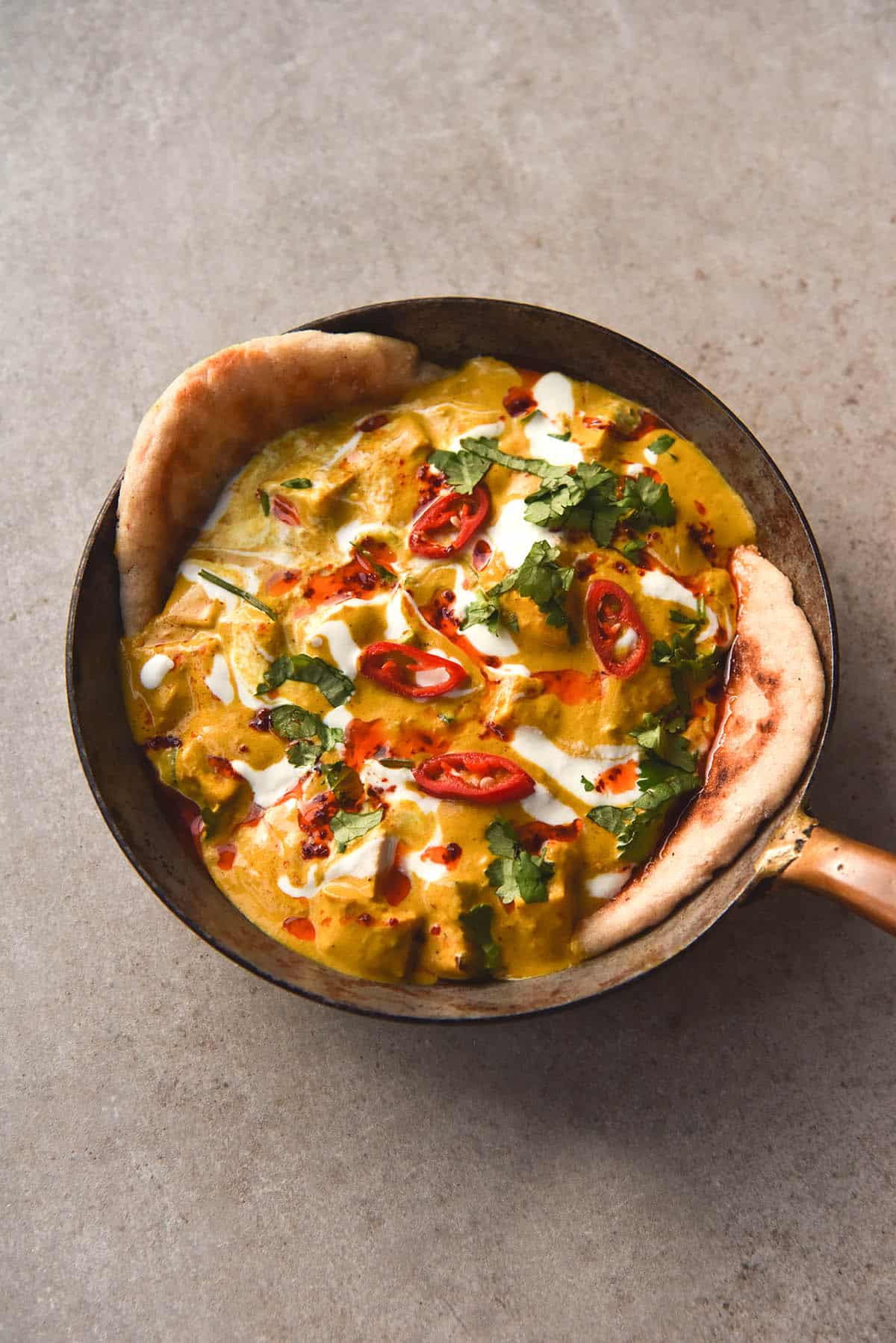
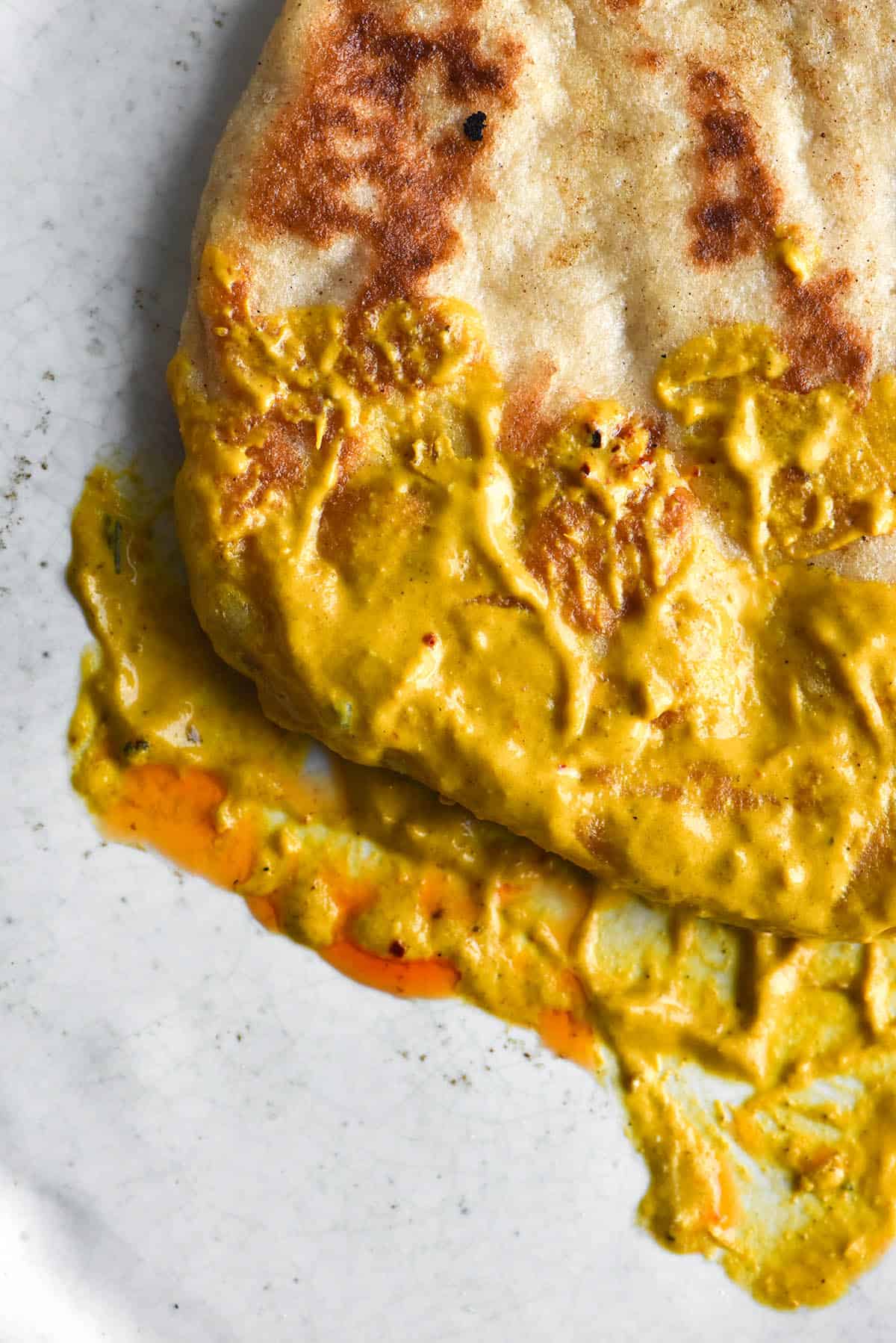
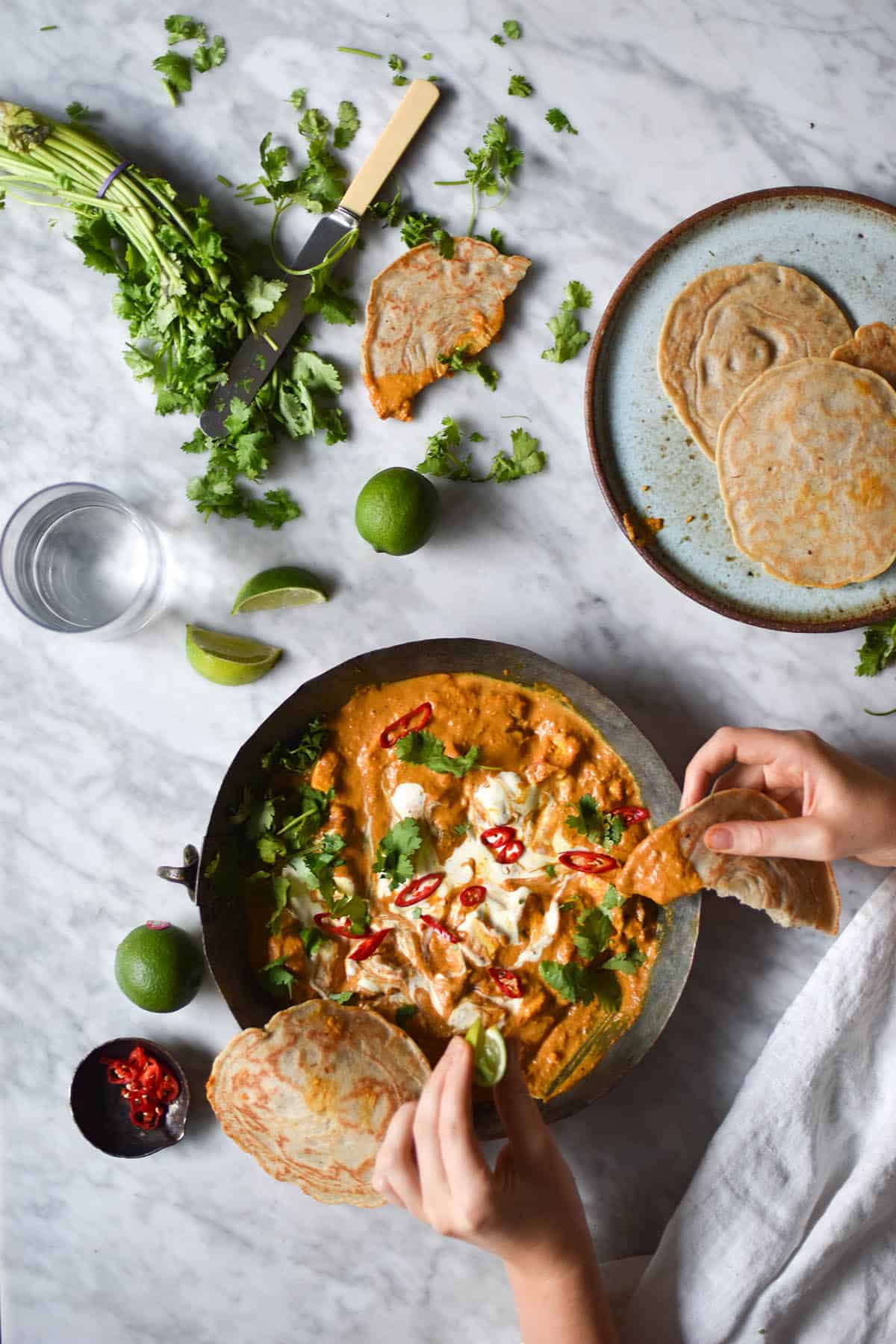
This looks amazing and I can’t wait to try it. Thanks for providing it.